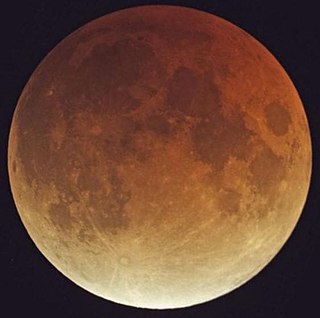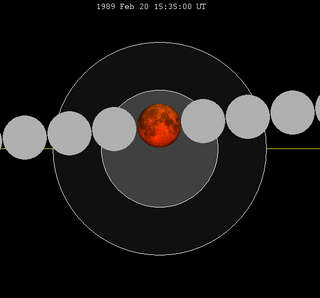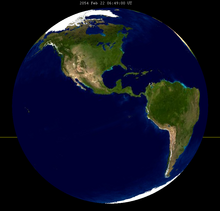
A total lunar eclipse occurred on February 20 and February 21, 2008. It was visible in the eastern evening sky on February 20 for all of North and South America, and on February 21 in the predawn western sky from most of Africa and Europe. Greatest Eclipse occurring on Thursday, February 21, 2008, at 03:26:03 UTC, totality lasting 49 minutes and 45.6 seconds.

A total lunar eclipse took place on Friday, February 9, 1990, the first of two lunar eclipses in 1990.

A penumbral lunar eclipse took place on 9 February 2009, the first of four lunar eclipses in 2009, and being the deepest of three penumbral eclipses. It also happened on the Lantern Festival, the first since 20 February 1989. The tables below contain detailed predictions and additional information on the Penumbral Lunar Eclipse of 9 February 2009.

A total lunar eclipse took place on Monday, February 20, 1989, the first of two total lunar eclipses in 1989.

A penumbral lunar eclipse took place at the Moon's ascending node on 11 February 2017, the first of two lunar eclipses in 2017. It was not quite a total penumbral lunar eclipse. It occurred the same day as comet 45P/Honda–Mrkos–Pajdušáková made a close approach to Earth. It also occurred on the Lantern Festival, the first since 9 February 2009. Occurring only 4.4 days after perigee, the moon's apparent diameter was larger.

A total lunar eclipse will take place on August 7, 2036. The southern tip of the Moon will pass through the center of the Earth's shadow. This is the last central lunar eclipse of Saros cycle 129.
A total lunar eclipse took place at the Moon's descending node of the orbit on Wednesday, February 10, 1971, the first of two total lunar eclipses in 1971. It had an umbral magnitude of 1.30819. The Moon passed through the center of the Earth's shadow. The Moon was plunged into darkness for 1 hour, 22 minutes and 11.4 seconds, in a deep total eclipse which saw the Moon 30.819% of its diameter inside the Earth's umbral shadow. The visual effect of this depends on the state of the Earth's atmosphere, but the Moon may have been stained a deep red colour. The partial eclipse lasted for 3 hours, 44 minutes and 42.9 seconds and in total. Occurring only 2.7 days before apogee, the Moon's apparent diameter was 5.9% smaller than average.
A penumbral lunar eclipse took place on Tuesday, January 20, 1981, the first of two lunar eclipses in 1981. In a rare total penumbral eclipse, the entire Moon was partially shaded by the Earth, and the shading across the Moon should have been quite visible at maximum eclipse. The penumbral phase lasted for 4 hours and 24 minutes in all, though for most of it, the eclipse was extremely difficult or impossible to see. The moon's apparent diameter was larger because the eclipse occurred 5.2 days after perigee.
A penumbral lunar eclipse will take place on Monday, March 25, 2024. It will be visible to the naked eye as 95.57% of the Moon will be immersed in Earth's penumbral shadow.

A penumbral lunar eclipse will take place on 20–21 February 2027.

A penumbral lunar eclipse will take place on February 22, 2035. It will be visible to the naked eye as 96.52% of the Moon will be immersed in Earth's penumbral shadow.
A partial lunar eclipse took place on Saturday, February 21, 1970. It was the first of two partial lunar eclipses in 1970, the other being on August 17 of the same year. A tiny bite out of the Moon may have been visible at maximum, though just 5% of the Moon was shadowed in a partial eclipse which lasted for 52 minutes and 42 seconds. A shading across the moon from the Earth's penumbral shadow should have been visible at maximum eclipse.

A total lunar eclipse will take place on January 1, 2048. It will be the first recorded lunar eclipse to be visible on New Year's Day for nearly all of Earth's timezones. The next such eclipse will occur in 2094.

A total lunar eclipse will take place on August 18, 2054.

A total lunar eclipse will take place on August 28, 2072.

A total lunar eclipse will take place on September 8, 2090.

A total lunar eclipse will take place on February 11, 2055.

A total solar eclipse will occur on December 5, 2048. A solar eclipse occurs when the Moon passes between Earth and the Sun, thereby totally or partly obscuring the image of the Sun for a viewer on Earth. A total solar eclipse occurs when the Moon's apparent diameter is larger than the Sun's, blocking all direct sunlight, turning day into darkness. Totality occurs in a narrow path across Earth's surface, with the partial solar eclipse visible over a surrounding region thousands of kilometres wide.

A partial solar eclipse will occur on Wednesday, January 27, 2055. A solar eclipse occurs when the Moon passes between Earth and the Sun, thereby totally or partly obscuring the image of the Sun for a viewer on Earth. A partial solar eclipse occurs in the polar regions of the Earth when the center of the Moon's shadow misses the Earth. It will be visible across North America.

A partial lunar eclipse will take place on August 7, 2055. It will last 3 hours, 23 minutes, and 23 seconds. It will be the last of the first set of partial eclipses in Lunar Saros 139.



































